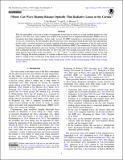Files in this item
(When) Can wave heating balance optically thin radiative losses in the corona?
Item metadata
| dc.contributor.author | De Moortel, Ineke | |
| dc.contributor.author | Howson, Thomas Alexander | |
| dc.date.accessioned | 2023-01-04T16:30:02Z | |
| dc.date.available | 2023-01-04T16:30:02Z | |
| dc.date.issued | 2022-12-14 | |
| dc.identifier | 281963836 | |
| dc.identifier | 805154ac-2c8f-4d0f-902c-cdb0b0e9bfd1 | |
| dc.identifier | 85144435954 | |
| dc.identifier | 000898334300001 | |
| dc.identifier.citation | De Moortel , I & Howson , T A 2022 , ' (When) Can wave heating balance optically thin radiative losses in the corona? ' , Astrophysical Journal , vol. 941 , no. 1 , 85 . https://doi.org/10.3847/1538-4357/aca072 | en |
| dc.identifier.issn | 0004-637X | |
| dc.identifier.other | ORCID: /0000-0002-4895-6277/work/124889198 | |
| dc.identifier.other | ORCID: /0000-0002-1452-9330/work/124889553 | |
| dc.identifier.uri | https://hdl.handle.net/10023/26669 | |
| dc.description | Funding: The research leading to these results has received funding from the UK Science and Technology Facilities Council (consolidated grant ST/N000609/1), the European Union Horizon 2020 research and innovation programme (grant agreement No. 647214). IDM received funding from the Research Council of Norway through its Centres of Excellence scheme, project number 262622. This work used the DiRAC Data Analytic system at the University of Cambridge, operated by the University of Cambridge High Performance Computing Service on behalf of the STFC DiRAC HPC Facility (www.dirac.ac.uk). This equipment was funded by BEIS National E-infrastructure capital grant (ST/K001590/1), STFC capital grants ST/H008861/1 and ST/H00887X/1, and STFC DiRAC Operations 650 grant ST/K00333X/1. DiRAC is part of the National e-Infrastructure. | en |
| dc.description.abstract | Why the atmosphere of the Sun is orders of magnitudes hotter than its surface is a long-standing question in solar physics. Over the years, many studies have looked at the potential role of magnetohydrodynamic (MHD) waves in sustaining these high temperatures. In this study, we use 3D MHD simulations to investigate (driven) transverse waves in a coronal loop. As the boundary-driven transverse waves propagate along the flux tube, the radial density profile leads to resonant absorption (or mode coupling) and phase mixing in the boundaries of the flux tube and the large velocity shears are subject to the Kelvin Helmholtz instability (KHI). The combination of these effects leads to enhanced energy dissipation and wave heating. Considering both resonant and non-resonant boundary driving as well as different densities for the flux tube, we show that only wave heating associated with a resonant driver in a lower density loop (with a loop core density ~5x10-13 kg/m-3) is able to balance radiative losses in the loop shell. Changing the model parameters to consider a denser loop or a driver with a non-resonant frequency, or both, leads to cooling of the coronal loop as the energy losses are greater than the energy injection and dissipation rates. | |
| dc.format.extent | 10 | |
| dc.format.extent | 1370148 | |
| dc.language.iso | eng | |
| dc.relation.ispartof | Astrophysical Journal | en |
| dc.subject | Sun: corona | en |
| dc.subject | Sun: oscillations | en |
| dc.subject | QB Astronomy | en |
| dc.subject | QC Physics | en |
| dc.subject | T-NDAS | en |
| dc.subject | MCC | en |
| dc.subject.lcc | QB | en |
| dc.subject.lcc | QC | en |
| dc.title | (When) Can wave heating balance optically thin radiative losses in the corona? | en |
| dc.type | Journal article | en |
| dc.contributor.sponsor | Science & Technology Facilities Council | en |
| dc.contributor.sponsor | European Research Council | en |
| dc.contributor.sponsor | Science & Technology Facilities Council | en |
| dc.contributor.institution | University of St Andrews. Office of the Principal | en |
| dc.contributor.institution | University of St Andrews. Applied Mathematics | en |
| dc.identifier.doi | https://doi.org/10.3847/1538-4357/aca072 | |
| dc.description.status | Peer reviewed | en |
| dc.identifier.grantnumber | ST/W001195/1 | en |
| dc.identifier.grantnumber | 647214 | en |
| dc.identifier.grantnumber | ST/S000402/1 | en |
This item appears in the following Collection(s)
Items in the St Andrews Research Repository are protected by copyright, with all rights reserved, unless otherwise indicated.

